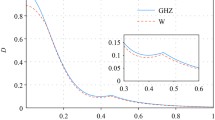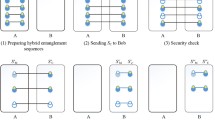Abstract
The quantum information network is important in establishing next-generation technology. In particular, maximal and long-distance entangled states are important in realizing a number of quantum information technologies, such as teleportation, key distribution and so forth. Entanglement swapping is a scheme that creates a long-distance network by using multiple short ones. Entanglement swapping protocols applied to non-maximal correlations have been thoroughly investigated by various people. Rather than providing any new analytic results, some examples of a numerical approach will be provided in this paper. In particular, the paper reveals the existence of different classes of coefficients that approximate the optimal outcome (i.e., the weaker average maximal entanglement between the two initial states). The new class of states is non-trivial in the sense that their coefficients are just as widely distributed as the coefficients of states satisfying optimality conditions are. Moreover, we will numerically examine entanglement swapping methods and show the distribution of optimal and general coefficients for three and four 2-level correlations.
Similar content being viewed by others
References
A. Peres, Quantum theory: concepts and methods (Kluwer, Dordrecht, 1997).
A. Einstein, B. Podolsky and N. Rosen, Phys. Rev. 47, 777 (1935).
J. S. Bell, Physics 1, 195 (1964).
A. Aspect, J. Dalibard and G. Roger, Phys. Rev. Lett. 49, 1804 (1982).
D. Deutsch, Proc. R. Soc. Lond. A 400, 97 (1985).
C. H. Bennett and G. Brassard, in Proceedings of IEEE International Conference on Computers, Systems and Signal Processing (Bangalore, India, December 1984), p. 75.
T. D. Ladd, F. Jelezko, R. Laflamme, Y. Nakamura, C. Monroe and J. L. O’Brian, Nature 464, 45 (2010).
P. Kok, W. J. Munro, K. Nemoto, T. C. Ralph J. P. Dowling and G. J. Milburn, Rev. Mod. Phys. 79, 135 (2007).
P. Shor, in Proceedings of the 35th Annual Symposium on the Foundations of Computer Science, edited by S. Goldwasser (IEEE Computer Society, Los Alamitos, CA), p. 124.
A. Ekert, Phys. Rev. Lett. 67, 661 (1991).
J. I. Cirac, A. Acin, M. Lewenstein and J. Wehr, Phys. Rev. A 77, 022308 (2008).
M. Zukowski, A. Zeilinger, M. A. Horne and A. K. Ekert, Phys. Rev. Lett. 71, 4287 (1993).
N. Boulant, K. Edmonds, J. Yang, M. A. Pravia and D. G. Cory, Phys. Rev. A 68, 032305 (2003).
R. Kaltenbaek, R. Prevedel, M. Aspelmeyer and A. Zeilinger, Phys. Rev. A 79, 040302 (2009).
C. H. Bennett, H. J. Bernstein S. Popescu and B. Schumacher, Phys. Rev. A 53, 2046 (1996).
H-K. Lo and S. Popescu, Phys. Rev. A 63, 022301 (2001).
D. Jonathan and M. B. Plenio, Phys. Rev. Lett. 83, 1455 (1999).
L. Hardy, Phys. Rev. A 60, 1912 (1999).
S. Popescu and D. Rohrlich, Phys. Rev. A 56, R3319 (1997).
S. Bose, V. Vedral and P. L. Knight, Phys. Rev. A 57, 822 (1998).
B-S. Shi, Y. Jiang and G-C. Guo, Phys. Rev. A 62, 054301 (2000).
L. Hardy and D. Song, Phys. Rev. A 62, 052315 (1999).
C. H. Bennett, G. Brassard, C. Crépeau, R. Jozsa, A. Peres and W. K. Wootters, Phys. Rev. Lett. 70, 1895 (1993).
G.’t Hooft, Class. Quant. Grav. 16, 3263 (1999).
S. Wolfram, A new kind of science (Wolfram media, Champaign, 2002).
P. A. Zizzi, Spacetime at the Planck scale: the quantum computer view. The Foundations of Quantum Mechanics, Historical Analysis and Open Questions-Cesena 2004 (Cesena, Italy 2006), p. 345.
S. Lloyd, Programming the universe (New York, 2006).
V. Vedral, Decoding reality: the universe as quantum information (Oxford University Press, 2010).
J. Schmidhuber, Computer universes and an algorithmic theory of everything. 2015. arXiv:1501.01373 (2015).
Author information
Authors and Affiliations
Corresponding author
Rights and permissions
About this article
Cite this article
Song, D. Some Numerical Cases of Entanglement Concentration Using Entanglement Swapping. J. Korean Phys. Soc. 74, 421–427 (2019). https://doi.org/10.3938/jkps.74.421
Received:
Accepted:
Published:
Issue Date:
DOI: https://doi.org/10.3938/jkps.74.421




